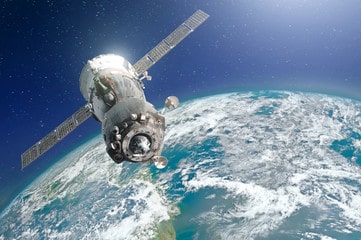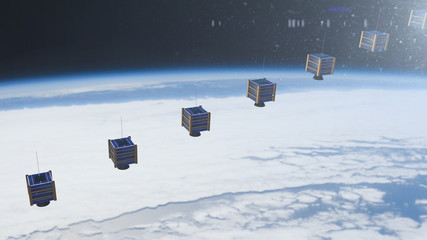Satellite launching processes were previously expensive. Since investments into this sector were yet to be proven worthwhile, many firms avoided sinking funds into uncertainty. In some cases, many firms and countries lacked the necessary equipment to conquer the new frontier. However, all that seems to be changing with the entry of multiple technology giants.
In the past, satellites were launched only from a designated place on the ground but technological advancement is revolutionizing this industry. Sir Richard Branson’s Virgin Orbit is among the private companies that have joined the race to launch satellites into orbit. Earlier this January, 10 payloads were lofted on the Virgin Orbit rocket that was launching from the wing of an old 747 Boeing jet.
Sir Branson is hoping to make a profit from the growing market for the small, lower-cost satellites. Previously, space has had high barriers to entry. Currently, only seven companies make up 75% of the sector, as highlighted by the director at Deloitte Ventures, Scott Campbell.
The satellite industry is worth around $380bn (£285bn), and 60% of that investment is commercial. In the past, almost all investment into space was done by governments. But, the real shift happened in 2011 when former US President Barack Obama opened up space to various private companies. Since then, a lot of disruption has happened and Mr. Campbell believes that more is coming:
“The new space race and start-up scene is almost entirely based around space applications: what can I do with data from space?”
Evolution Of The Satellite Industry
Initially, developing and launching a functional satellite to collect data or enable different forms of communications to cost hundreds of millions. These satellites weighed up to six tonnes with many of them reaching the size of a bus. They would be sent up into geostationary orbit which is 35,786km (22,236 miles) above the Earth.
But things have changed drastically. It is now possible to send a nanosat that weighs 25-50kg into low-Earth orbit about 160-1,000km above Earth for $100,000 to $1,000,000. Mark Boggett, the chief executive of Seraphim Capital, a British venture capital firm, said that the launch prices are dropping since tech firms are driving demand. He commented:
“Because tech firms need to launch their own satellites in the thousands [for space internet networks], this further drives down the cost of launch and storage for everyone else. Whole new industries of businesses can benefit from using this data, essentially democratising space.”
As more satellites are launched into orbit and space, more data gets transmitted back to earth. This data needs someone to process it which has made Deloitte’s Scott Campbell see “an explosion of businesses around space”. Between 2011 and 2018, space-related companies in the UK alone increased from 234 to 948.
In the case of the satellites, there are about 9,000 in orbit today, as highlighted by Seraphim. Since 2016, Planet, Amazon, OneWeb, Spire, and SpaceX have put up almost 10% of these satellites. But, 200 other small companies are coming up behind them who are expected to launch up to 25,000 satellites in the next four years.
NanoAvionics, the nanosat manufacturer, is among the smaller manufacturers. The company unveiled its plans in October to create up to 400 new jobs in Britain as it saw its revenues surge by 300% in 2020.
The head of operations at NanoAvionics UK, Robin Sampson, commented:
“In the old days, we launched one satellite that had lots of sensors on it. But today, we’ve launched hundreds of satellites that have the same one sensor, and that’s a much cheaper, repeatable way to do it with more consistent data.”
Dinesh Patel is PWC UK’s space lead. He estimated that the nanosat market is currently worth about £1.8bn but its annual growth rates are projected at 20%.
In the past, satellites were used for TV services, communications, and tracking the weather around the world. However, the emergence of new cheaper options is attracting many tech giants that have big plans.
Microsoft Partners With SpaceX
Microsoft announced its partnership with Elon Musk’s SpaceX late last year in a move that might take the space business to higher levels. Their partnership, dubbed Azure pace, plans to integrate Microsoft’s cloud computing features and components with a global network of satellites.
The corporate vice president at Microsoft Azure, Tom Keane, said that space now makes it possible to push computing to the edge. This means that it will be possible to process data much nearer to users’ devices than ever before. Keane explained:
“The edge could be anywhere – on a device… you’re wearing, it could be something you’re carrying, it could be in your car. Space allows you to connect all of that infrastructure, and then you can use artificial intelligence [like] predictive analytics to gain insights over things that were previously not connected.”
Interestingly, the ground stations that receive loads of data from satellites are a possible moneymaker for the IT giants.
Keane is committed to revolutionizing the ground stations that are, for now, “expensive and often monolithic devices.” He wants to link them up with Microsoft’s data centers.
“Today, in many cases, data [from ground stations] may not be used, or it’s certainly not used as broadly as it could be. By connecting that ground station, you take the data from space… to solve problems that you can’t solve today.”
Benefits And Shortcomings
Another benefit of this technological advancement is the connection of around 3.8 billion people in rural areas who currently have no form of internet connection. Since 2018, SpaceX has been launching groups of small satellites into orbit. It is gradually forming a huge constellation that aims to offer instant broadband everywhere around the world.
Other companies and businesses will also hope to make some money by collecting a lot of data from nanosats, processing it using artificial intelligence (AI), and then using it innovatively to solve real-life challenges.
Companies are also aiming to acquire Earth observation data including heat signatures, weather, and atmospheric gas composition to enable people, for example, farmers, to monitor flood defenses, construction sites, and traffic.
However, some critics think that constellations of satellites orbiting near the Earth are a bad idea.
The chief executive of Vertical Bridge, Alex Gellman, believes that many limitations affect space broadband due to latency. Vertical Bridge is the biggest privately-owned communications infrastructure firm in the United States.
Latency records the amount of time taken to receive a response after one sends out a data request. For instance, the latency through the air is around 3.3 microseconds/km when sending data over a 4G mobile network.
On the other hand, data sent over fiber broadband in the cases where the signal moves through a glass, the latency is 5 microseconds/km. Interestingly, the nanosats are many miles away. Gellman explained:
“If the satellite has to communicate with a ground base station to compute, [the data] has to go back to the satellite, and then to your device, so it could be four round trips before it gets to the device. Satellites do bring internet to places that don’t have it, but it’s not a service comparable to 4G or 5G ultimately.”
Space Trash
Also, there is the issue of space trash as highlighted by a senior member at IEEE, Paul Kostek. He said:
“We’re talking thousands of small satellite launches and there’s a traffic management problem that people have not really encountered before. What happens if one satellite gets hit by space debris, breaks apart and goes into the orbit of another constellation? You’ve added more debris in orbit around the Earth.”
He did not say that geostationary satellites will become obsolete in the future. Bu, most legacy space companies are worried. Mr. Kostek concluded:
“Everyone’s trying to work out where they fit in. There’s going to be a shake-up going forward.”
When will mankind conquer Mars? It might happen sooner than expected with more companies joining the race to explore whatever is on offer in space.












